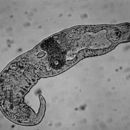en
names in breadcrumbs


The Gnathostomulida are translucent microscopic, interstitial (i.e., living between sediment particles) marine worms, with a muscular pharynx armed with distinctive forceps-like jaws in nearly all species. Gnathostomulids feed on bacteria, fungi, and protists. The elongate body, which is typically less than 2 mm long (range 0.3 to 3.5 mm), usually has distinct head, trunk, and tail regions. Outer epithelial cells each have single cilia which collectively help the animal glide between sand grains. The ventral mouth leads to a blind gut (i.e., the gut has just a single opening, rather than a separate mouth and anus), but undigested solid waste may leave not only through the mouth but also via a temporary anus or temporary doraal connection to the epidermis. Gnathostomulids are hermaphrodites, either simultaneously functioning as male and female or as male first. One egg matures at a time and fertilization is apparently internal; in at least some species, sperm are apparently injected by an individual beneath the skin of its mate. Fertilized eggs are believed to be deposited singly. Development is direct, with no larval stage.
Gnathostomulids are found worldwide, but the best studied areas are western Europe, the Mediterranean Sea, the U.S. coastline, the Caribbean Sea, and a few localities in the Pacific Ocean. They are found mainly in medium or fine-grained sand mixed with detritus and are often very common in sand from seagrass beds. They may occur at high densities in anoxic, sulfide-rich conditions (population densities of more than 6000 individuals per liter of sediment have been reported). They occur from the intertidal zone to depths of hundreds of meters. There are close to 100 described gnathostomulid species, but many more times that number likely await discovery. Gnathostomulids were first described, in 1956, as turbellarian Platyhelminthes (free-living flatworms), but were given phylum rank in 1969. Recent work has supported the recognition of a monophyletic clade Gnathifera consisting of the clade Syndermata (Rotifera + Acanthocephala) plus the Gnathostomulida (Witek et al. 2009 and references therein). Sørensen et al. (2006) investigated relationships within the Gnathostomulida.
(Brusca and Brusca 2003; Sørensen and Sterrer 2009 and references therein; Margulis and Chapman 2010)
Gnathostomulids are found worldwide.
Gnathostomulids are found mainly in medium or fine-grained sand mixed with detritus and are often very common in sand from seagrass beds. They may occur at high densities in anoxic, sulfide-rich conditions (population densities of more than 6000 individuals per liter of sediment have been reported). They occur from the intertidal zone to depths of hundreds of meters.
(Brusca and Brusca 2003; Sørensen and Sterrer 2009 and references therein; Margulis and Chapman 2010)
The elongate body of a gnathostomulid, which is typically less than 2 mm long (range 0.3 to 3.5 mm), usually has distinct head, trunk, and tail regions. Outer epithelial cells each have single cilia which collectively help the animal glide between sand grains. The ventral mouth leads to a blind gut (i.e., the gut has just a single opening, rather than a separate mouth and anus), but undigested solid waste may leave not only through the mouth but also via a temporary anus or temporary dorsal connection to the epidermis.
(Brusca and Brusca 2003; Sørensen and Sterrer 2009 and references therein; Margulis and Chapman 2010)
Gnathostomulids are hermaphrodites, either simultaneously functioning as male and female or as male first. One egg matures at a time and fertilization is apparently internal; in at least some species, sperm are apparently injected by an individual beneath the skin of its mate. Fertilized eggs are believed to be deposited singly. Development is direct, with no larval stage.
(Brusca and Brusca 2003; Sørensen and Sterrer 2009 and references therein; Margulis and Chapman 2010)
There are close to 100 described gnathostomulid species, but many more times that number likely await discovery. Gnathostomulids were first described, in 1956, as turbellarian Platyhelminthes (free-living flatworms), but were given phylum rank in 1969. Recent work has supported the recognition of a monophyletic clade Gnathifera consisting of the clade Syndermata (Rotifera + Acanthocephala) plus the Gnathostomulida (Witek et al. 2009 and references therein). Sørensen et al. (2006) investigated relationships within the Gnathostomulida.
(Brusca and Brusca 2003; Sørensen and Sterrer 2009 and references therein; Margulis and Chapman 2010)